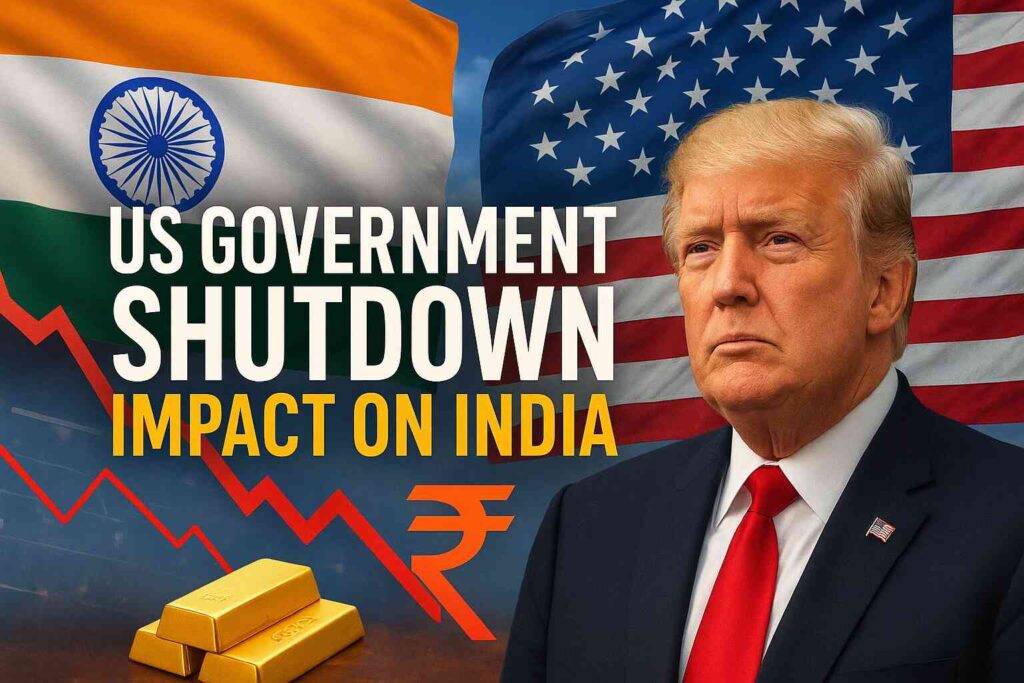The United States government officially entered a shutdown on October 1, 2025 after Congress failed to pass stopgap funding. While the immediate scene is Washington — furloughed federal staff, closed offices and paused programs — the ripple effects quickly cross oceans. For India, the impact shows up in currency moves, markets, trade flows, travel and visa services, the IT sector, and everyday people who work with or in the U.S.
This article explains, in plain language, how the us government shutdown affects India now and what could happen if the shutdown lasts longer. I use the latest available reporting and official signals to highlight real, current effects and clear actions to watch.

Table of Contents
Quick snapshot — five plain facts India needs to know now
- Rupee and markets are jittery. The Indian rupee has fallen and markets are nervous because the shutdown increases global uncertainty.
- Gold and safe-haven assets are rising. Investors moved into gold as a safe place to park money after the shutdown news. That pushes local gold prices up in India.
- Visa and consular services could be delayed. The U.S. Mission to India said routine updates may pause and some services could run on a limited basis while the shutdown is in effect. Applicants should expect possible delays.
- Market links mean second-order effects. Indian stocks and bonds feel any major dip or volatility in U.S. markets because foreign fund flows change quickly. Analysts expect a short-term shock rather than a long-term collapse — but uncertainty is costly. mint
- Longer shutdowns amplify pain for trade and people. If the impasse lasts weeks, the effects widen: export orders could slow, payrolls of U.S. buyers could be hit, and visa or immigration backlogs could grow.
Why a US government shutdown matters for India — the simple chain
A US government shutdown may sound like a domestic political drama, but three clear channels bring the impact to India:
- Financial channel (currency, markets, investments). Global investors hate uncertainty. When Washington stalls, U.S. growth forecasts wobble, the dollar moves, and international investors may reduce risk exposure — including selling Indian assets. That weakens the rupee and can push Indian stocks down.
- Trade and business channel. Some U.S. government functions support trade (customs data, certifications, buyer payments for government contracts). If those slow, Indian exporters and supply-chain partners can see delayed payments or logistics headaches. Private U.S. demand can also fall if many workers are furloughed and spending drops.
- People-to-people and services channel (visas, travel, IT staffing). India’s large pool of professionals, students and tourists travel to or work with the U.S. Any slowdown in visa processing, immigration adjudication or travel logistics directly affects people and companies. Recent policy moves around H-1B and related visas already add stress; a shutdown can slow processing further.
US government shutdown impact on Currency & markets: the immediate picture
When the shutdown began, the rupee weakened further, adding to a recent run of depreciation that had already strained import bills and investor confidence. A weaker rupee makes oil and dollar-priced imports more expensive for India, raising costs for businesses and consumers. It also raises the local currency value of any dollar-denominated debt Indian firms carry.
Equity markets react fast to uncertainty. While some analysts believe short shutdowns cause only temporary volatility, a prolonged shutdown—especially paired with other U.S. policy shocks—could reduce foreign portfolio flows into Indian equities and push Indian investors to seek safer assets like gold or U.S. Treasuries. That move to safe havens was visible: gold prices rose sharply when the shutdown was confirmed.
What this means for you: if you hold rupee assets, expect short-term volatility. If you trade internationally, budget for wider currency swings and slightly higher hedging costs.
US government shutdown impact on Trade & exports: ripple effects and chokepoints
India exports many goods and services to the U.S., ranging from pharmaceuticals, gems and textiles to services such as IT and business process outsourcing. A U.S. shutdown can affect exports via:
- Delayed payments or orders: Government procurement that relies on federal funding could be postponed, and private buyers may delay big purchases if government staff and contractors miss paychecks.
- Customs and certifications: Some regulatory checks involve U.S. agencies; slowdowns add friction to cross-border trade.
- Shipping and air traffic effects: If agencies like the FAA reduce staff or process fewer certifications, air cargo schedules and passenger flows can be affected, slowing logistics and raising costs. Recent warnings signaled possible furloughs at the FAA that could disrupt aviation efficiency.
Sector examples: gems and jewelry exporters could face slower premium orders; pharmaceutical shipments that need U.S. regulatory sign-offs may be delayed; and perishable goods face higher spoilage risk if customs processes slow.
Practical tip for exporters: Confirm orders, check buyer liquidity, add buffer days to delivery schedules, and alert logistics partners to the evolving situation.

US government shutdown impact on Indian IT industry, H-1B and talent flows
India’s technology services firms have major links to the U.S. market: clients, project work and talent movements. Two dynamics matter now:
- Short-term operational pain: If federal clients in the U.S. pause projects or slow procurement, Indian IT firms with government contracts may see work delayed. Even where private clients reduce spending, project timelines can stretch.
- Longer-term visa policy changes: Independent of the shutdown, the U.S. government has recently signaled changes to H-1B rules and fee structures that could raise costs and change how U.S. companies hire foreign workers. If these policy shifts proceed alongside processing slowdowns from the shutdown, Indian professionals could face higher hurdles and longer waits for approvals.
What IT companies and employees should do now: Indian firms should accelerate onshore hiring where possible, prepare remote-delivery options, re-evaluate visa-dependent staffing plans, and communicate proactively with U.S. clients about timelines.
US government shutdown impact on Travel, visas and students — real people effects
A government shutdown frequently affects visa and immigration services because several U.S. departments run on annual appropriations. The U.S. Mission to India warned that routine social media updates might pause and that visa and passport services would continue “as the situation permits,” but applicants should be ready for possible delays.
- Student visas: Admissions and onboarding for fall or spring semesters can be disrupted if visa appointments or SEVIS processing slows. International students should stay in touch with university international offices and check embassy updates.
- Work visas and green cards: Labor certification and other adjudications can be paused — slowing H-1B, PERM and other processes. Immigration lawyers warn that shutdowns create backlogs and uncertainty that ripple into hiring decisions.
- Tourists and business travelers: Some routine services may continue, but expect slower response times for queries and rescheduling.
Practical advice for travelers and applicants: Don’t make irreversible plans based on tight timelines. Reach out to the embassy or consulate and to the institution (employer/university) sponsoring your visit to get contingency guidance.
US government shutdown impact on Commodities and inflation: gold and oil
India is a major buyer of gold, both for investment and cultural reasons. When global uncertainty rises, gold often benefits because investors view it as a safe store of value. The us government shutdown raised safe-haven demand and helped push gold to record levels in global markets — that filters into higher local gold prices and can influence inflation expectations for households that hold gold.
Oil markets are also sensitive to geopolitical and macro risk. If the shutdown slows U.S. demand or affects shipping and insurance costs, oil price swings can follow. For India — a large oil importer — higher oil prices add to the import bill and can fuel domestic inflation.
US government shutdown impact on Banks, remittances and payments
Remittances from the U.S. to India are a steady source of foreign exchange for many households. A shutdown that reduces paychecks among U.S. federal employees or slows private spending can temporarily reduce remittance flows. Payment processing is largely private-sector, but if the shutdown affects banking regulators or cross-border payment confirmations, there may be minor delays.
For Indian banks with U.S. exposure, short shutdowns are unlikely to cause immediate solvency problems. But prolonged uncertainty can hurt sentiment and increase funding costs.
US government shutdown : What Indian policymakers might do
India’s central bank (RBI) and finance ministry monitor global risk closely. Possible responses include:
- Currency intervention: The RBI may step in to smooth rupee volatility, using foreign exchange reserves or allowing market mechanisms to operate with targeted liquidity. Recent commentary suggests RBI already considered measured interventions during recent pressures.
- Monetary guidance: If global risk pushes local inflation up via higher commodity prices, RBI policy signals may adapt to balance growth and inflation.
- Communication to investors: Clear public messaging helps calm markets and reassure foreign investors that India remains open for business.
US government shutdown Scenario planning — what happens if the shutdown lasts longer?
Short shutdown (days): mostly market jitters, small dips in the rupee and stock indices, some visa scheduling delays. Countries and companies typically weather these with limited long-term damage.
Medium shutdown (several weeks): larger market volatility, visible hit to consumer demand in the U.S., more visa backlogs, slowing projects for Indian exporters and IT firms, temporary trade frictions. Gold and safe-havens climb higher.
Long shutdown (months): potential for sustained capital outflows from emerging markets, deeper hit to India’s exports and services that rely on U.S. demand, travel and student flows could be badly delayed, political and policy uncertainty could feed into investor caution and higher borrowing costs. This would be the costliest scenario and is why markets pay close attention to how quickly Congress and the White House resolve the funding gap.
What businesses and individuals in India can do — practical checklist
For exporters and businesses
- Reconfirm contracts with U.S. buyers and build contingency clauses.
- Add buffer time to shipments and invoices.
- Talk to logistics partners about alternative routes and faster customs clearance options.
- Hedge currency risk if you have significant dollar exposure.
For IT firms and recruiters
- Prepare remote delivery or onshore alternatives.
- Evaluate talent plans with visa uncertainty in mind.
- Communicate with U.S. clients about contingency timelines.
For students and migrants
- Stay in contact with sponsors and educational institutions.
- Keep copies of all documents and maintain flexible travel plans.
- Monitor official embassy channels for the latest processing status.
For individual investors
- Expect short-term volatility; avoid panic selling.
- Consider diversified holdings and think about hedging currency risk if needed.
- Keep an eye on safe havens (gold) and core portfolio allocation.
Final take US government shutdown : short-term pain, long-term outlook depends on duration
A us government shutdown is disruptive and costly — not just for the U.S. — and India will feel the aftershocks via currency moves, market sentiment, trade frictions, and visa delays. The good news: markets have historically absorbed short shutdowns without structural damage, and policymakers can use tools to soften immediate pain. The bad news: the longer the shutdown continues, the broader and deeper the impact for Indian businesses and citizens who depend on smooth links with the United States.
Right now (October 1, 2025), the immediate signs are falling rupee, a record surge in gold demand, warnings about furloughs and aviation staff impacts, and notices from the U.S. Mission in India about limited consular communication. Keep these five watch-points in mind: rupee levels, foreign fund flows, visa processing updates, gold and oil prices, and RBI/FMO statements.
Disclaimer: This article and accompanying image are for informational and illustrative purposes only. The image is a digitally created representation and not an actual photograph. Economic impacts and policy outcomes may vary; readers are advised to consult official sources for the latest updates.

